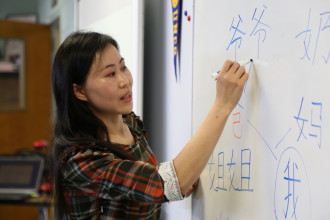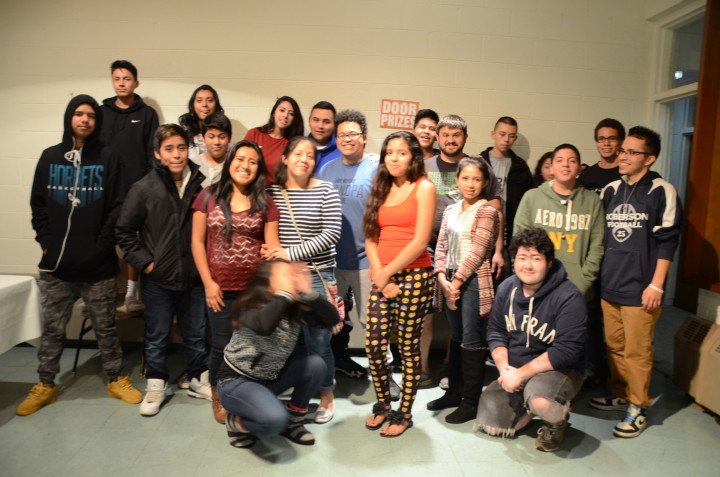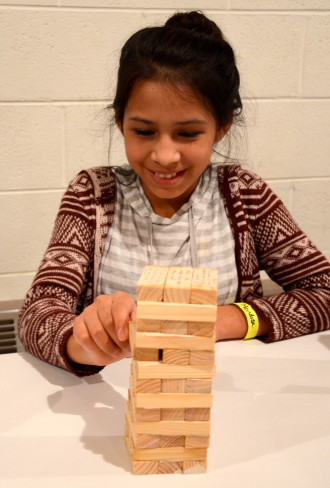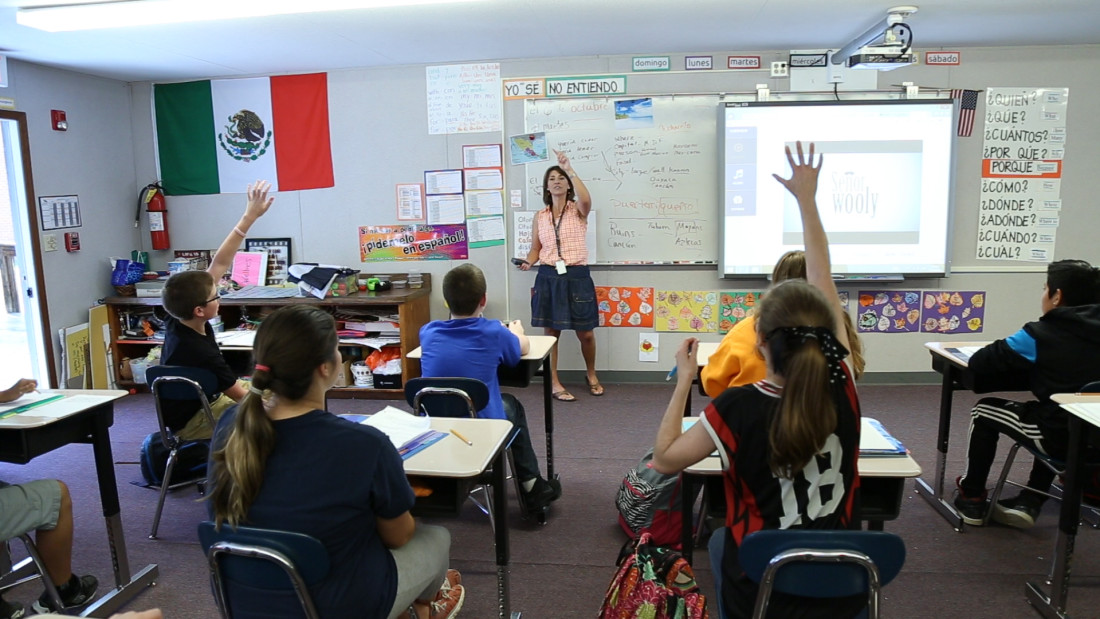Southern Appalachia has often been seen as an insular backwater, though Asheville has served as a cross-cultural meeting ground for more than a century. And in Buncombe County today, nearly 7 percent of the population is Hispanic, census data show. There are also concentrations of other groups, including Asians, Eastern Europeans and Pacific Islanders.
Transitioning to a new language, country and culture can be extremely disruptive — particularly for children, who are just beginning the process of learning to understand themselves and their heritage even as they enter a foreign school system.
To address the growing numbers of students from non-English-speaking households, the Asheville and Buncombe County schools are gradually developing a curriculum that gives students from all backgrounds a chance to explore what makes each tradition unique, fostering cross-cultural dialogue and preparing students to be productive members of today’s increasingly global society.
Polyglot learning
In the past few years, the number of students in the county schools whose first language isn’t English has ballooned. Hispanic students alone now account for almost 16 percent of the system’s total enrollment (3,870 out of 24,527), and there more than 71 languages are spoken in its 43 schools. “We’re much more diverse than we’ve been in the past,” notes Student Services Director David Thompson.
To meet these students’ needs and satisfy federal guidelines, the county schools are expanding their curriculum. It begins with a home language survey for new students, says Geneva Neeriemer, the system’s interim director of federal programs.
Children needing additional language help are connected with a teacher of English as a second language. “There’s a teacher that serves nearly every one of our schools,” says Neeriemer, adding that the Erwin, Roberson and Enka school districts have the greatest need for ESL classes. Those teachers, she continues, “provide English support, helping them learn not only conversational but academic language.”
Creating a welcoming, comfortable environment, however, takes more than teaching language skills, stresses Thompson. “Many of our students coming from other countries are fleeing violence,” he explains. “They’re coming in straight from that and then dealing with their own immigration experiences ― sometimes a significantly traumatic experience.”
Last year, the county schools began implementing a social/emotional learning curriculum for all students that’s designed to teach them “how to have conversations with each other, how to problem-solve and do conflict resolution, how to recognize and accept differences.” The current program covers only kindergarten through fifth grade, but Thompson says the district plans to expand it through eighth grade in the 2016-17 school year.
Each school, he adds, also offers various clubs with a focus on cultural issues, to help encourage dialogue. “Kids can organize and lead a student group to talk about their differences and commonalities,” particularly at the middle and high school levels, where cultural variances may become more apparent.
Cultural exchange
In the Asheville City Schools, 8 percent of the system’s 4,400 students are Hispanic, says Charlie Glazener, the director of communications. There are also sizable populations of Asian students and Pacific Islanders.
Schools across the city are implementing personalized, digital evaluation methods that factor in the particulars of each student’s background and educational history. The system’s strategic plan also emphasizes open dialogue among parents, students and teachers to help determine what each student needs. In addition, new digital information technologies are being integrated into the curriculum to supplement classroom lessons.

When it comes to languages, the city schools believe in starting young. “We’re the only district in all of WNC that offers Spanish in all our elementary schools on a regular basis,” says Glazener. “We have Spanish teachers throughout the five schools, and depending on grade level, they meet with each class for a certain amount of time each week.”
At the high school level, Spanish, Chinese, French and Latin are offered. “Students learn about different languages and cultures while, at the same time, acquiring better study skills and absorbing more comprehensive knowledge of English grammar,” Glazener explains. The Chinese teachers “come for one to three years and teach three classes every day. The students get pretty immersed in those classes: It’s not just the language exchange; there’s a whole lot of cultural exchange.”
Meanwhile, Students in Action, a new youth-led group at Asheville High, is mentoring incoming students to ease their transition from the lower grades, hoping to close the academic gap between minority and white students.
Helping hands
Outside organizations also play a role. MANOS, an affiliate of Children First/Communities In Schools, serves Latino students in both the city and county systems, offering help with homework, college preparation programs and, most importantly, a safe, stress-free environment where students can relax. An acronym for “mentoring and nurturing our students,” manos is also the Spanish word for “hands.”
“In my world, the magic words are ‘information, information, information,’” says Norma Brown, the nonprofit’s Latino outreach coordinator. “Many families — not just Latinas — don’t have access to or information about available resources,” notes Brown, who describes herself as somewhat of a “cultural broker between the English- and Spanish-speaking communities.”
“We’re a unique organization in that we not only provide direct services but also do advocacy work to ensure that local and state policies are in place to support children and families,” she explains. “My role is to ensure that Latino families have access to services, programs and information in a way that relates to their cultural background, talents and challenges.”

MANOS, a Latino youth group that grew out of a collaboration between Children First/Communities In Schools and Warren Wilson College, helps students build their leadership skills, civic engagement and college preparedness in a safe and inviting space.
In response to the growing numbers of local Spanish-speaking students, her organization has placed student support specialists in several schools, including Johnston and Emma elementaries and Eblen Intermediate.
“At Emma Elementary, which has 425 children, there are 18 countries represented and eight languages spoken,” notes Brown. “We have staff placed in the elementary schools and within the communities of the children and families we serve, because we know that for a child to be successful at school, issues at home have to be addressed first ― such as hunger, health care, housing and more.”
MANOS pairs Latino youth in grades eight to 12 with Warren Wilson College students, who serve as academic and social mentors and advisers. Every Monday, Brown reports proudly, 22 youths “participate full of hope, knowing that this is their space, where they can always be themselves and talk to a mentor.”
Biliterate and bilingual
The county schools are also starting language study at an early age. In 2011, the Splash language-immersion program was introduced at Glen Arden Elementary. Beginning in kindergarten, the Splash curriculum, developed by VIF International Education, offers classroom instruction in Spanish as well as English, either on alternate days or on parts of days. “The idea is to immerse them in a second language in the curriculum area, so when they leave, they’re biliterate and bilingual,” says Cheri Boone, the system’s global education coordinator. Buncombe, she adds, is one of a growing number of school systems statewide that participate in such programs.
VIF, a Chapel Hill-based educational firm, cites studies from around the world showing that multilingual students typically process information faster; develop a more mature, multifaceted understanding of the world; have improved memory and cognitive functions; and generally enter adulthood more prepared for the rigors of the modern workplace.
The first group of students in the Glen Arden pilot program is now in fourth grade. “I visited the school the other day: It was amazing to see the language skills these students have developed at the fourth-grade level,” says Boone, adding, “They were very proud of themselves.”
Building on Splash’s success at Glen Arden, she notes, similar programs at Oakley, W.D. Williams and Averys Creek elementary schools now offer an expanded two-way immersion curriculum that helps immigrant students learn English while they assist native English speakers who are studying the immigrant’s language and culture. “This program includes either a two-thirds-to-one-third demographic population or a 50-50 split, meaning 50 percent is native English speakers and the other half is native Spanish speakers,” Boone explains. “They’re not only learning their curriculum area in Spanish, but they’re also being able to have that social, informal dialogue in both languages.”
These efforts, says Boone, reflect one of Superintendent Tony Baldwin’s top priorities for the county schools: “global initiatives and education in general.”
And as students move through the system, Boone and other global education staffers hope the dual language immersion program will follow them. “We’ve been rolling out one school each year and increasing [them] by grade level each year as well,” she notes. Eventually, the district would like to have the model run from kindergarten all the way to graduation.
At the secondary level, students in the county schools can currently choose from among five language study programs: Spanish, French, German, Chinese and Latin. They can also take various culturally related courses through North Carolina Virtual Public School, a free, state-sponsored online program. In addition, the school system is developing a global education website, Boone reports, where students, teachers and parents can stay up to date on the various initiatives underway.

Community and competition
Several city schools also offer cultural immersion programs combining language education with other activities to foster a sense of community in a diverse student body.
Last year, Hall Fletcher Elementary launched its Common Ground ESL program for immigrant families, a partnership involving A-B Tech, students, parents and volunteers. The program offers cultural enrichment classes for both children and parents, aiming to “enhance the lives of families” through things like nutritional education, a community gardening project, and interaction between English- and non-English-speakers in a casual, friendly atmosphere.
At Ira B. Jones Elementary, the Global Scholars program incorporates service-learning opportunities into language classes, environmental studies and multicultural offerings. “We seek opportunities for grade levels to bring global perspectives to their classrooms while learning with the world, not just about it,” according to an online description of the program.
And at Isaac Dickson Elementary, the FLEX curriculum offers Spanish classes to develop awareness and appreciation of a foreign culture, Spanish teacher Shannon Fields explains in an online Q&A.
It’s not just about diversity and sensitivity, either, stresses Glazener. “It’s kind of a worn-out phrase, but our young people in this community might be competing with kids in India, China and other countries for jobs in the future. There’s more competition these days. The more young people are exposed to culture and other languages, the better they’re going to fare in the global economy.”
A top-down model
Efforts to expand multicultural offerings aren’t focused solely on students, however. The Global Educator Digital Badge, a statewide program implemented by the Department of Public Instruction, offers faculty, administrators and staff an opportunity to increase their ability to facilitate a cross-cultural curriculum.
“Basically, it’s preparing teachers through 100 hours of professional development and global education that’s tied to their personal developmental goals,” says Boone. Over the course of two years, staff members build credit hours within five “action item” areas aligned with the North Carolina Professional Teaching Standards. Local and state panels assess program participants’ development; if approved, the staff member is certified.
“It’s helping them look at the standards they’re held accountable to and improve their instructional practice, as well as student learning and being a globally competent citizen,” Boone explains.
Seventeen teachers in the Buncombe County Schools are enrolled in the Global Educator program, and school officials hope to involve more in the coming years. “We’re excited to grow that program and help prepare our students to become globally aware and globally competent graduates,” says Boone.
Administrators are also encouraging parents from other cultures to participate in classroom activities and dialogue with school officials from the get-go. “One of the issues we’re really addressing is reaching out to our parents of students from other cultures to help them feel accepted,” says Thompson. Such communication, he adds, also helps administrators understand the differences between foreign and American educational systems and evaluate a student’s prior academic work in their homeland.

Brown agrees, adding that parents’ involvement in the curriculum can help alleviate the stress for immigrant students who must serve as a bridge between two worlds. “Many of our youth have the opportunity to learn English before their parents,” she notes, calling it “both a blessing and a curse” that can “negatively affect not only the quality of communications between the parent and the professional, but also the family dynamics.” Making third-party interpreters available, says Brown, spares the children from having to be “cultural brokers at a very young age.”
Think globally, act locally
Officials in both systems hope the various initiatives currently being offered will coalesce into a comprehensive K-12 program that prepares students to go on to postsecondary education or enter the workforce with a sense of global awareness and bilingual competency.
“No pun intended, but it’s taking a global look at what we’re doing,” says Boone. “It’s not just language acquisition: It’s understanding the culture as well. The two go hand in hand.”
For her part, Brown praises the attitude of teachers and administrators alike. “I see a great deal of commitment on the part of staff, teachers and administrators,” she says, adding that school officials have welcomed feedback on how to better serve their students.
“Language barriers are a tremendous obstacle,” she notes, “but poverty and trauma are still the root cause of many of these challenges.” Effective multicultural programs, she continues, provide a window into “the complex reality that many students and their families face.”




Before you comment
The comments section is here to provide a platform for civil dialogue on the issues we face together as a local community. Xpress is committed to offering this platform for all voices, but when the tone of the discussion gets nasty or strays off topic, we believe many people choose not to participate. Xpress editors are determined to moderate comments to ensure a constructive interchange is maintained. All comments judged not to be in keeping with the spirit of civil discourse will be removed and repeat violators will be banned. See here for our terms of service. Thank you for being part of this effort to promote respectful discussion.